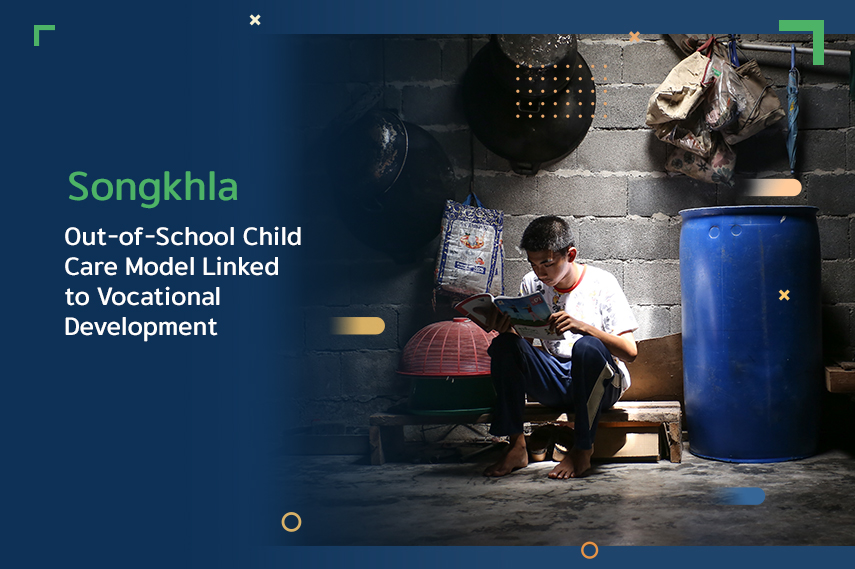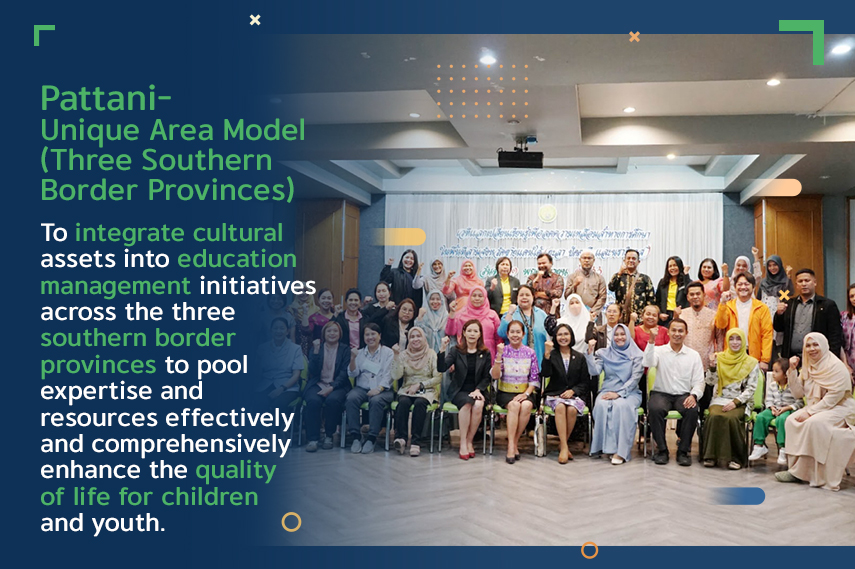
Songkhla Out-of-School Child Care Model Linked to Vocational Development

Objective: To assist out-of-school and at-risk children and youth by addressing root causes and enhancing opportunities, both educational and occupational.
Key Component:
-
- Interagency Collaboration: Facilitate province-wide dialogues and collaborations among educational stakeholders;
- Establish “Community Learning Centers” to provide alternative education pathways, offering tailored curricula and assessing learning outcomes for credit recognition;
- Expand the network of “Schools of Life” to seamlessly connect educational institutions, ensuring smooth transitions for children and youth across all levels of education;
- Interagency Collaboration: Facilitate province-wide dialogues and collaborations among educational stakeholders;
- Real-Time Data Access:
-
- Develop a provincial database system involving 12 collaborating agencies to collect and share educational data on out-of-school and at-risk children and youth, including those involved in the legal process, and mobilize resources, fostering informed decision-making;
- Develop a mobile application for real-time access to personalized data, aiding targeted assistance and ensuring timely support for continued education and compulsory education completion.
Potential Implication:
- Improved Access: Ensure better access to education for out-of-school and at-risk children and youth;
- Tailored Support: Tailor comprehensive assistance to specific educational needs, promoting inclusivity;
- Community Engagement & Empowerment: Empower local stakeholders to actively contribute to educational initiatives;
- Sustainable Educational Development: Foster confidence in marginalized households, encouraging sustained engagement with the education system.
The Songkhla Out-of-School Child Care Model prioritizes interagency collaboration and real-time data access to tackle educational disparities for out-of-school and at-risk children and youth. It establishes “Community Learning Centers” and expands the “Schools of Life” network for alternative education pathways. With a provincial database system and a mobile application, the model ensures informed decision-making and targeted assistance, including compulsory education completion. It guarantees improved access and tailored support, empowering communities and fostering sustainable educational development. These efforts instill confidence and sustained engagement within households, driving long-term socio-economic progress. Ultimately, the model equips youth with vital skills for future workforce participation and societal contribution.
Surat Thani Provincial Equitable Education Fund Office and Equity Fund Model

Objective: To increase access to quality education for all children and youth, irrespective of their backgrounds or abilities.
Key Component:
- Interagency Collaboration: Facilitate province-wide dialogues and collaborations among diverse agencies, including non-educational entities, to pool expertise and resources effectively;
- Develop a diverse range of approaches to address the needs of children and youth, with a focus on flexibility, adaptability, inclusivity, and relevance;
- Encourage leadership from key individuals within each organization, fostering a sense of ownership and commitment to the initiative’s success;
- Data & Resource Management:
- Develop a comprehensive database system to collect and analyze educational data from multiple agencies, ensuring accurate and accessible information for informed decision-making;
- Link resources within the communities, including facilities, personnel, and organizations, to create a comprehensive educational ecosystem and ensure targeted support for those communities with the greatest need;
Potential Implication:
-
- Improved Access: Ensure better access to education for children and youth;
- Community Engagement & Empowerment: Foster a sense of ownership and responsibility and contribute to holistic development;
- Sustainable Educational Development: Ensure equitable access to educational opportunities, fostering a culture of continuous improvement and innovation;
- Social Cohesion Enhancement: Promote inclusivity, diversity, and social cohesion;
- Sustainable Development: Contribute to long-term socio-economic development.
The Surat Thani Provincial Equitable Education Fund Office and Equity Fund Model prioritizes equitable access to education for all, irrespective of socio-economic background or abilities. Through collaborative efforts among diverse agencies, including non-traditional educational bodies, it harnesses collective resources to address educational disparities comprehensively. A sophisticated database system enables informed decision-making by analyzing educational data from various sources. Emphasizing flexibility and inclusivity, the initiative tailors support efforts to meet the unique needs of each community, fostering empowerment and sustainable development. Not only does its commitment to democratizing education ensure immediate access, but it also lays the groundwork for future prosperity by nurturing a skilled workforce and driving socio-economic advancement.
Pattani – Unique Area Model (Three Southern Border Provinces)

Objective: To integrate cultural assets into education management initiatives across the three southern border provinces to pool expertise and resources effectively and comprehensively enhance the quality of life for children and youth.
Key Component:
-
- Interagency Collaboration: Facilitate province- and region-wide dialogues and collaborations among diverse agencies, including public, private, civil society, and educational sectors, to collectively enhance education quality and address dropout rates;
- Develop a comprehensive database system to gain a comprehensive understanding of the educational landscape, ensuring accurate and accessible information for targeted assistance efforts;
- Mobilize various resources and funds, aligning with local beliefs and practices to foster community development;
- Interagency Collaboration: Facilitate province- and region-wide dialogues and collaborations among diverse agencies, including public, private, civil society, and educational sectors, to collectively enhance education quality and address dropout rates;
- Tailored Learning Environment Establishment
-
- Effectively utilize cultural assets to establish foundations and stimulate further strategic thinking;
- Establish conducive learning environments for children and youth to enhance opportunities and growth, nurturing holistic development.
Potential Implication:
-
- Improved Access: Ensure better access to education for children and youth;
- Community Engagement & Empowerment: Foster resilience and self-sufficiency in addressing educational challenges;
- Quality of Life Improvement: Elevate the quality of life for residents in underserved areas;
- Social Cohesion Enhancement: Promote inclusivity, diversity, and social cohesion;
- Sustainable Development: Contribute to long-term socio-economic development.
The Pattani Unique Area Model harmonizes educational management efforts across the three southern border provinces: Pattani, Yala, and Narathiwat, to enhance the well-being of children and youth. Through extensive interagency collaboration involving diverse stakeholders from public, private, civil society, and educational sectors, expertise and resources are pooled to elevate educational quality and address dropout rates. A comprehensive data system is developed, laying the groundwork for tailored interventions. Meanwhile, establishing conducive learning environments and aligning resources with community beliefs by utilizing cultural assets fosters holistic development and empowerment. Implications range from improved educational access and community engagement to enhanced quality of life, social cohesion, and sustainable socio-economic development. The model addresses current challenges while fostering skilled and empowered communities, promoting inclusivity, and driving growth for a prosperous future.

